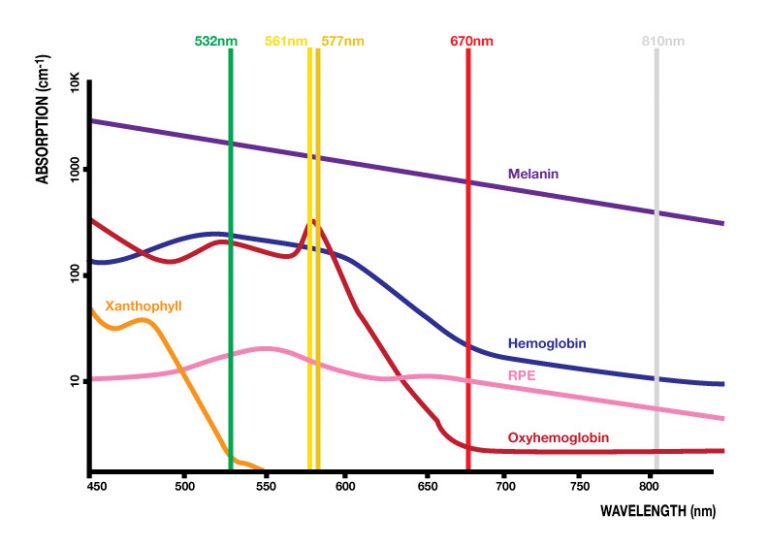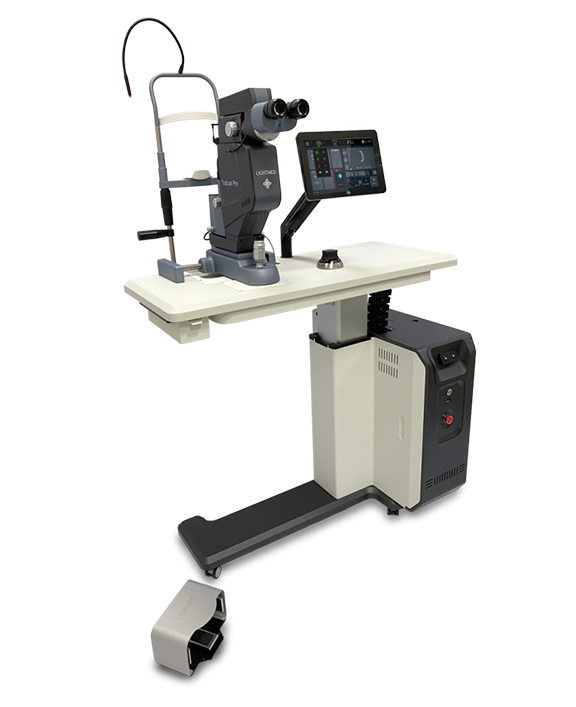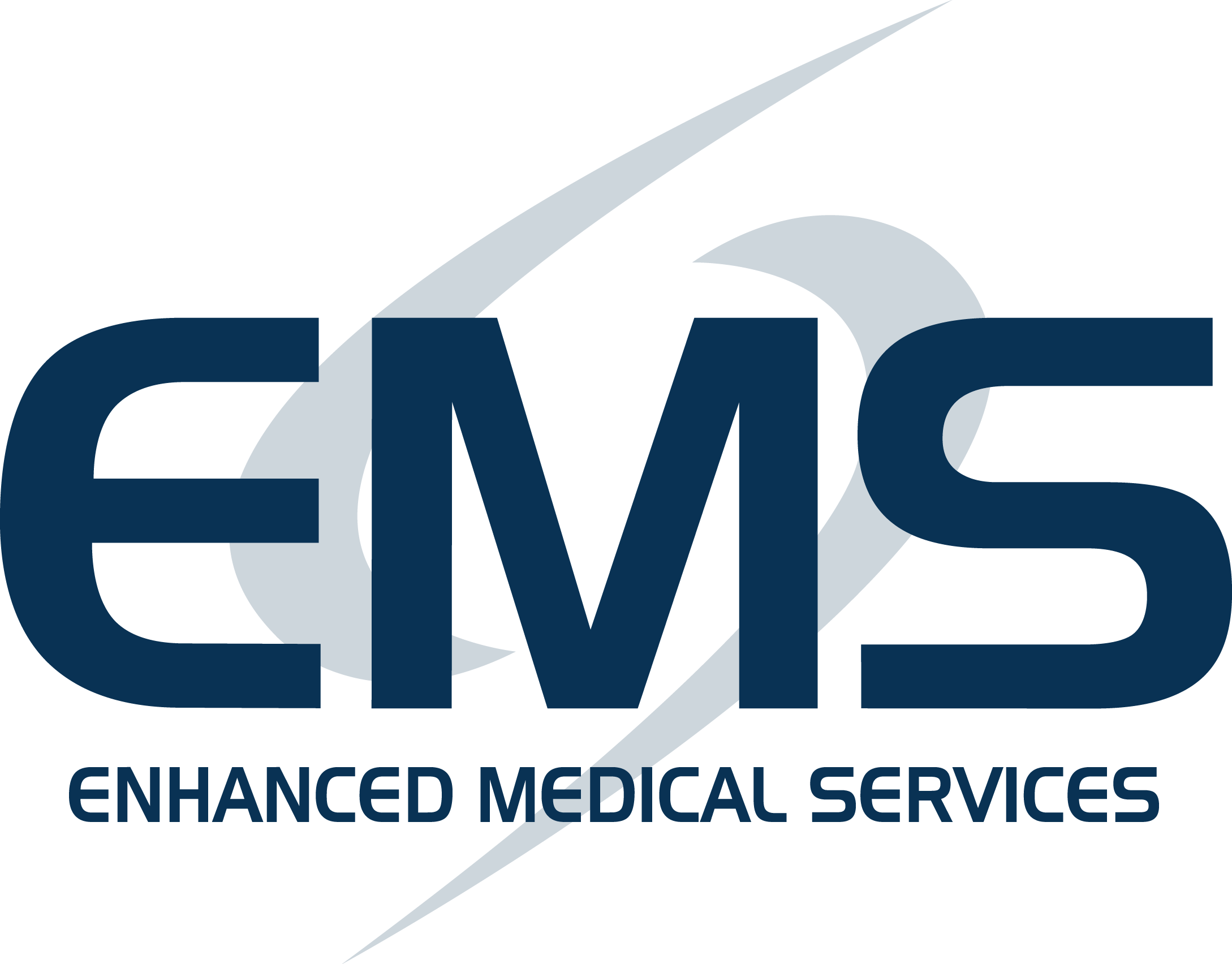Emerging technologies such as multi-wavelength lasers provide safe treatments and optimal therapeutic impact. The most effective wavelengths for laser treatments are those that present the most favorable tissue absorption properties, depending on the disease.
LIGHTMED offers the widest portfolio of laser products for the ophthalmic market with a wide range of wavelength configurations that include 532nm green, 561nm or 577nm yellow, 670nm red and 810nm infrared.
The 532nm green laser is the proven standard in photocoagulation. Its wavelength benefits include being highly absorbed by melanin and well absorbed by hemoglobin. The 532nm wavelength is clinically proven to treat a large variety of retinal disorders. Its main clinical applications include retinal photocoagulation (panretinal photocoagulation, diabetic retinopathy, central/branch retinal vein occlusion, retinal tears, holes & detachments, endophotocoagulation) and glaucoma (laser trabeculoplasty and SP-Mode® laser trabeculoplasty).
The 561nm or 577nm yellow laser is the new gold standard to treat the macula. Its wavelength benefits include being highly absorbed by melanin, having peak absorption in oxyhemoglobin, negligible absorption by xanthophyll pigments and is low light scattering. The 561nm or 577nm wavelength is useful for treating a large variety of retinal disorders, is suitable for treating the macula, useful for treating abnormal vasculature and offers reduced treatment pain.
The yellow laser’s main clinical applications include retinal photocoagulation (panretinal photocoagulation, diabetic retinopathy, central/branch retinal vein occlusion, retinal tears, holes & detachments, endophotocoagulation, diabetic macular edema/focal photocoagulation), SP-Mode® macular laser treatment (diabetic macular edema, central serous chorioretinopathy), and glaucoma (laser trabeculoplasty and SP-Mode® laser trabeculoplasty).
The 670nm red laser is the ideal choice when opacities are present. Its wavelength benefits include being well absorbed by melanin, minimally absorbed by hemoglobin, having negligible absorption by xanthophyll pigments, good penetration through media hemorrhage and opacity, and is well penetrated through the sclera. The 670nm wavelength is useful for treating the retina through vitreous and retinal hemorrhages or media opacity, and is also useful for the transscleral approach.
The red laser’s main clinical applications include retinal photocoagulation especially under conditions with medial opacities or hemorrhage (panretinal photocoagulation, diabetic retinopathy, central/branch retinal vein occlusion, retinal tears, holes & detachments, endophotocoagulation), SP-Mode® macular edema (diabetic macular edema, central serous chorioretinopathy), and glaucoma (transscleral cyclophotocoagulation, SP-Mode® transscleral cyclophotocoagulation and SP-Mode® laser trabeculoplasty).
The 810nm infrared laser is the versatile alternative for deep penetration. Its wavelength benefits include being well absorbed by melanin, minimally absorbed by hemoglobin, having negligible absorption by xanthophyll pigments, good penetration through media hemorrhage, deep choroidal reach, minimal absorption in the crystalline lens, well penetrated through the sclera and having absence of flash light. The 810nm wavelength is useful for treating retina or choroid through vitreous and retinal hemorrhages or media opacity, is suitable for approaching the choroid, suitable for the treatment of retinopathy of prematurity (avoiding cataract formation), useful for the transscleral approach and is comfortable due to the absence of flash light.
The infrared laser’s main clinical applications include retinal photocoagulation especially under conditions with medial opacities or hemorrhage (panretinal photocoagulation, diabetic retinopathy, central/branch retinal vein occlusion, retinal tears, holes & detachments, endophotocoagulation, retinopathy of prematurity), SP-Mode® macular laser treatment (diabetic macular edema, central serous chorioretinopathy), glaucoma (transscleral cyclophotocoagulation, SP-Mode® transscleral cyclophotocoagulation, SP-Mode® laser trabeculoplasty), and transpupillary thermotherapy (choroidal tumor).
LIGHTMED offers a variety of retina lasers including the TruScan Pro, LIGHTLas 532, LIGHTLas 577 and LIGHTLas 810. Each laser is configurable for the needs of your clinic or hospital.
For more information about LIGHTMED’s retina lasers, email sales@lightmed.com or visit www.lightmed.com.
Contributed by LIGHTMED.
Dr. Tarkek Alasil discusses the effectiveness of multiple wavelengths in laser technology.


Emerging technologies such as multi-wavelength lasers provide safe treatments and optimal therapeutic impact. The most effective wavelengths for laser treatments are those that present the most favorable tissue absorption properties, depending on the disease.
LIGHTMED offers the widest portfolio of laser products for the ophthalmic market with a wide range of wavelength configurations that include 532nm green, 561nm or 577nm yellow, 670nm red and 810nm infrared.
The 532nm green laser is the proven standard in photocoagulation. Its wavelength benefits include being highly absorbed by melanin and well absorbed by hemoglobin. The 532nm wavelength is clinically proven to treat a large variety of retinal disorders. Its main clinical applications include retinal photocoagulation (panretinal photocoagulation, diabetic retinopathy, central/branch retinal vein occlusion, retinal tears, holes & detachments, endophotocoagulation) and glaucoma (laser trabeculoplasty and SP-Mode® laser trabeculoplasty).
The 561nm or 577nm yellow laser is the new gold standard to treat the macula. Its wavelength benefits include being highly absorbed by melanin, having peak absorption in oxyhemoglobin, negligible absorption by xanthophyll pigments and is low light scattering. The 561nm or 577nm wavelength is useful for treating a large variety of retinal disorders, is suitable for treating the macula, useful for treating abnormal vasculature and offers reduced treatment pain.
The yellow laser’s main clinical applications include retinal photocoagulation (panretinal photocoagulation, diabetic retinopathy, central/branch retinal vein occlusion, retinal tears, holes & detachments, endophotocoagulation, diabetic macular edema/focal photocoagulation), SP-Mode® macular laser treatment (diabetic macular edema, central serous chorioretinopathy), and glaucoma (laser trabeculoplasty and SP-Mode® laser trabeculoplasty).
The 670nm red laser is the ideal choice when opacities are present. Its wavelength benefits include being well absorbed by melanin, minimally absorbed by hemoglobin, having negligible absorption by xanthophyll pigments, good penetration through media hemorrhage and opacity, and is well penetrated through the sclera. The 670nm wavelength is useful for treating the retina through vitreous and retinal hemorrhages or media opacity, and is also useful for the transscleral approach.
The red laser’s main clinical applications include retinal photocoagulation especially under conditions with medial opacities or hemorrhage (panretinal photocoagulation, diabetic retinopathy, central/branch retinal vein occlusion, retinal tears, holes & detachments, endophotocoagulation), SP-Mode® macular edema (diabetic macular edema, central serous chorioretinopathy), and glaucoma (transscleral cyclophotocoagulation, SP-Mode® transscleral cyclophotocoagulation and SP-Mode® laser trabeculoplasty).
The 810nm infrared laser is the versatile alternative for deep penetration. Its wavelength benefits include being well absorbed by melanin, minimally absorbed by hemoglobin, having negligible absorption by xanthophyll pigments, good penetration through media hemorrhage, deep choroidal reach, minimal absorption in the crystalline lens, well penetrated through the sclera and having absence of flash light. The 810nm wavelength is useful for treating retina or choroid through vitreous and retinal hemorrhages or media opacity, is suitable for approaching the choroid, suitable for the treatment of retinopathy of prematurity (avoiding cataract formation), useful for the transscleral approach and is comfortable due to the absence of flash light.
The infrared laser’s main clinical applications include retinal photocoagulation especially under conditions with medial opacities or hemorrhage (panretinal photocoagulation, diabetic retinopathy, central/branch retinal vein occlusion, retinal tears, holes & detachments, endophotocoagulation, retinopathy of prematurity), SP-Mode® macular laser treatment (diabetic macular edema, central serous chorioretinopathy), glaucoma (transscleral cyclophotocoagulation, SP-Mode® transscleral cyclophotocoagulation, SP-Mode® laser trabeculoplasty), and transpupillary thermotherapy (choroidal tumor).
LIGHTMED offers a variety of retina lasers including the TruScan Pro, LIGHTLas 532, LIGHTLas 577 and LIGHTLas 810. Each laser is configurable for the needs of your clinic or hospital.
For more information about LIGHTMED’s retina lasers, email sales@lightmed.com or visit www.lightmed.com.
Contributed by LIGHTMED.
Dr. Tarkek Alasil discusses the effectiveness of multiple wavelengths in laser technology.


